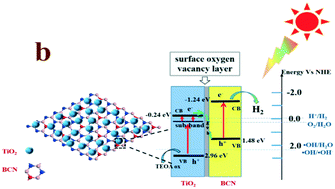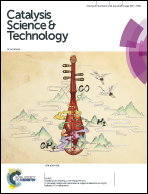Interfacial oxygen vacancy layer of a Z-scheme BCN–TiO2 heterostructure accelerating charge carrier transfer for visible light photocatalytic H2 evolution†
Abstract
All-solid-state Z-scheme BCN–TiO2 binary heterostructures with a surface oxygen vacancy layer as the contact interface are fabricated by NaBH4 reduction and ball milling. The effect of the surface oxygen vacancy layer of BCN–TiO2 binary heterostructures on the charge carrier transfer and photocatalytic hydrogen evolution was thoroughly investigated. UV-vis diffuse reflection spectra results reveal that the surface oxygen vacancy can extend the light absorption from the UV to the visible-light region for BCN–TiO2 binary heterostructures. The steady-state/time-resolved photoluminescence spectra exhibit an increased charge carrier lifetime, improved charge carrier separation efficiency and strengthened direct Z-scheme charge transfer process for BCN–TiO2−x heterostructures. As expected, the BCN–TiO2−x heterostructures exhibited a higher visible-light photocatalytic efficiency, about 7 and 11 times higher than that of the pure TiO2 and BCN samples. Namely, the photocatalytic activity of hydrogen evolution can be greatly promoted by constructing the surface oxygen vacancy layer. This work provides a new pathway to construct an efficient contact layer for the direct Z-scheme system to improve the charge carrier separation and transfer and thereby improve the photocatalytic activity.



 Please wait while we load your content...
Please wait while we load your content...